Since 1895, cultural institutions from around the world have gathered at the Venice Biennale to present the latest developments in their country’s visual arts, performance, and design. With the Biennale attracting over 500,000 visitors last year, prospective contributors vie to present new projects and exhibitions. In 2015, the Art Biennale, focusing on advances in contemporary art, featured 138 artists from 53 countries.
For the 56th and 57th Art Biennale, the U.S. Department of the State’s Bureau of Educational and Cultural Affairs selected two university museums from the Greater Boston Area to represent America at the U.S. Pavilion. The List Visual Arts Center at the Massachusetts Institute of Technology (MIT) was selected to commission the last presentation, a much-deserved exhibition by influential artist Joan Jonas, led by Commissioner Paul Ha, and it was recently announced that in 2017 the Rose Art Museum at Brandeis University will present an exhibition by the L.A. based, multimedia artist and social activist, Mark Bradford, led by Rose Director, Christopher Bedford.
In hopes to record this moment, I set out to interview Ha and Bedford for BR&S to gauge what this repeated recognition means for Boston’s local academic, institutional, and curatorial community. After interviewing Christopher Bedford, I met with Paul Ha in his office at the List Visual Arts Center to discuss the commissioning and production of Joan Jonas’s exhibition, They Come to Us Without a Word.
Sam Toabe: When was the first time you encountered Jonas’s work, and when did you realize you wanted to collaborate with her in presenting and contextualizing her artwork at the Venice Biennale? How did it come together?
Paul Ha: I was introduced to Joan's work in college, and came to understand that she was one of the pioneers of performance and video art. When I started my work here at MIT, I knew that she was a professor here. I immediately reached out to her. I had thought of proposing her for a Venice Biennale immediately. I met with her and we decided to put in the application, and then you just wait. Like a year later you get a phone call saying that you've been chosen.
When you get the phone call you have to start forming teams right away. One of the things Joan asked for was a larger studio so that she can do a bigger production, and we did that for her in the West Village (New York City). And then to create the team that can help her in the studio, make sure you set up a fundraising team and get a team committed to help install the work in Venice.
With Joan's work, there are a lot of things that you had to think about. There are videos, there are props, some major installation, and editing on site. So we had a team for installation, but also one for sound and video editing while in NY and on site in Venice.
We were there in the pavilion every day from 9am till 7 pm, constantly working. Joan was there editing the video until the last minute, and finding the sound that she needed, making sure that she has the right footage. She created eight new videos for the installation in addition to creating the stage sets and the props. It was a major production.
ST: What was the application process like?
PH: Having been on a couple of committees that chose the artists for the Biennale, I knew that it's the strength of the proposal and the committee's ability to visualize [the exhibition].
I know that it's the strength of the individual proposal that’s the reason why it gets chosen. I am sure that the Mark Bradford proposal must have been very strong, and that the people on the committee must have gotten very excited about it. I believe that the committee chooses the artist that they want to see.
ST: And it's also about a zeitgeist, the gathering of a particular group of people.
PH: Exactly, so it's all about the energy in the room. I know that there are wonderful, thoughtful discussions, and arguments as well, and, in the end, they propose what they think is the strongest.
ST: Ute Meta Bauer was here when you proposed it.
PH: Right, and I knew I could use her assistance with it as well. She worked on Documenta 11, and I knew working together, we could better support Joan.
ST: Was this the first Biennale that you have produced a project for? What was the whole whirlwind of the experience like for you?
PH: Definitely. What added to the whirlwind was that I had just started working here. Learning a new institution and pushing us forward, understanding the moment and the importance of working with a great artist, like Joan, just added to the whirlwind. It was a large project, but also a really gratifying project.
ST: Jonas has emphasized that her work is not didactic, stating that she utilizes a “non-verbal” visual language. In one interview she says “I want to tell my viewers ‘don’t try to understand it, just experience it.’” How did that primacy of experience affect the conceptualization of the exhibition, its design, and its programming?
PH: I think her installation that was created for the Pavilion: it was all experiential. You go from this bright light of Venice, and you walk into this dark room, and then immediately there seems to be a buffer between you and the outside world. The five rooms that she created-- Bees, Wind, Fish, Homeroom, and Mirrors-- there was a direction that she sort of gave you, a physical direction. There was a linearity between the rooms. As you're experiencing it, you're not quite understanding the connection of each room, but as you walk out they start automatically connecting creating a story and a narrative. The story and narrative are different for each of the viewers.
What's interesting is at the past few Biennales at the US Pavilion, they have all been installations: Sarah Sze, Allora, Calzadilla. Two Biennales ago [MIT alumnus] Jennifer Allora exhibited work [alongside Guillermo Calzadilla]. Allora was a student of Joan’s at MIT.
I'm interested in seeing what Mark Bradford does at the Pavilion. The US Pavilion is a challenging space, in that it's five small rooms, with not great light. It's not like the Scandinavian Pavilion, which is really beautiful and elegant. So I think the challenge is, "what do you do with it?" and "how do you make your work fit into that space, and have it shine?" What Joan did was brilliant. She immediately turned off all of the lights so you can't see the space and she made you focus on the new videos that she created.
She made this piece out of five immersive atmospheres. What a lot of people said about the US Pavilion during the opening weekend, because it's a hectic thing trying to see everything, was that when you walked into the US Pavilion you immediately had to slow down. It made you feel grounded. I thought that was a real gift that Joan gave to the Biennale.
ST: What was your first significant experience of the Venice Biennale?
PH: It was in 1990. Anish Kapoor at the British Pavilion just had a really strong impact on me. How these objects just sort of absorbed you. I stayed in there for a very, very long time. That was a significant moment for me.
ST: When did you first realize that you wanted to participate in the Venice Biennale?
PH: In 1999, I sent in a proposal, and we didn't get it. But it's interesting that that year it was Ann Hamilton, and it was MIT who got it. So it's sort of fortuitous in a way. And I'm not sure if it's true or not, but I was told that we were second place. I think they might have told that to everybody involved. What was really rewarding was the gentleman that called me from the State Department in 1998 (because we proposed in 98) was the same guy who called me to say that we got it in 2014.
ST: How do think Joan made her mark with this presentation amongst other great showings by Bill Viola, Félix González-Torres, Louise Bourgeois, Fred Wilson, and the like?
PH: I think the Biennale is great in that, since its inception in 1895, each year it marks what's happening then in the art world.
What's amazing about Joan is that she's been thinking about this for a long time. She, with a small group of individuals, mostly out of New York, created this new art form called Performance Art. Back then, they didn't have a term for it. They called it “happenings” back then. What’s really exciting is that just ten years ago, none of the major museums around the world had a Curator of Performance Art. They had Curators of painting or sculpture, but now, only forty years later, there's this new scholarship being developed. There are museums collecting this form of art, and propagating it. It says to me there are new forms of art that are going to be created that we don't know yet. So 50 years from now, what else will there be? What curator of "what" will be created for institutions? That's really exciting to me. And Joan is a big part of why this new scholarship is being created because she and her small group of individuals started it forty or fifty years ago.
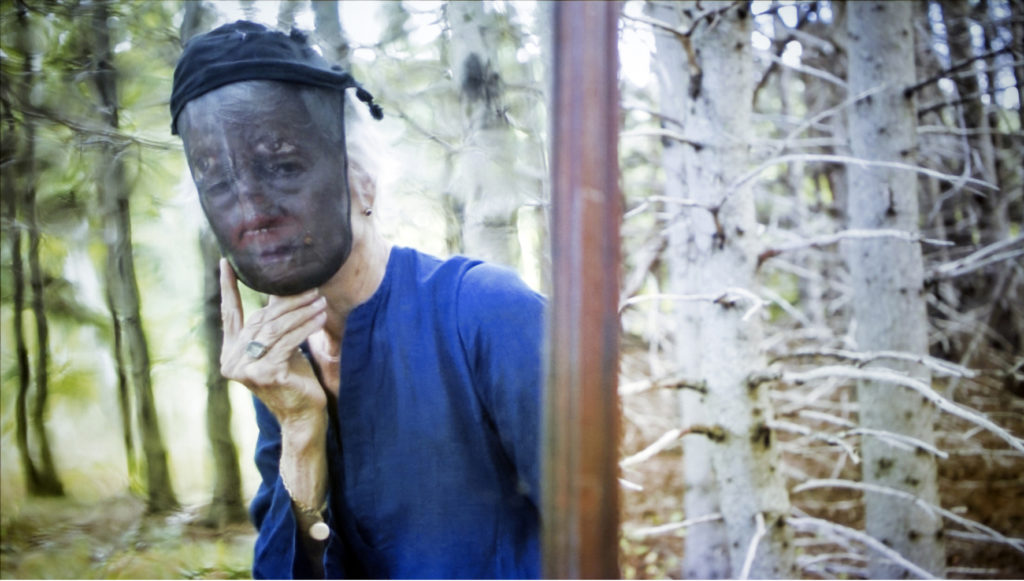
Joan Jonas, They Come to Us without a Word, 2015. Production Still. Courtesy of the artist.
ST: Joan Jonas is widely regarded in Europe as a significant American artist, while she has lacked proper institutional and commercial representation in the US. How do you hope her representation at the Venice Biennale will affect her recognition within the canon of contemporary art in American?
PH: The fact that Joan was so successful in her installation, it's already having an impact on her career. She's being collected more widely by institutions. Right now she's being honored by so many institutions, it's delightful to see. She's being offered exhibitions all around the world. People are recognizing that she needs additional attention.
ST: What was the process like for you, being a Director and Curator based in Cambridge working with an artist based in New York on an exhibition set in Venice?
PH: The great thing about being in Boston is it's relative closeness to NY. On a whim, I can go down to NY, and see what's going on, or if she emailed me and said "I need help with this," I was able to go down in four or five hours. And with new technologies like skype, it's much easier to be five hours away.
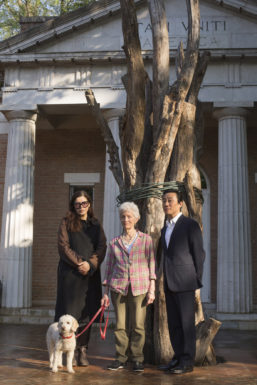
Ute Meta Bauer, Joan Jonas, her dog Ozu, and Paul Ha. Photo by Moira Ricci.
We took two scouting trips out to Venice. The initial scouting trip was to look at the Pavilion, and to measure it and take photographs. Also, we went to different venues where she could do a performance. We ended up at the Arsenale, the Teatro Piccolo, which was the perfect size. To do [the performance]over three nights was a great idea by Joan. It added so much because most of the children who were in the video were actually the actors in the performance as well. So it was incredible to experience the performance and the installation.
ST: The exhibition received a great deal of press since it was announced in 2014. Is there anything that hasn’t been covered by that body of work that you wish there was more emphasis on?
PH: What I'm really excited about is what Joan does next. She's at the top of her game in a way. She totally delivered at the Pavilion. [She said] "I was given this space, here's what I've been thinking, here's what I produced," and the people just walked away shaking their heads. It was fantastic. And now she's done a couple of performances and had some exhibitions. I'm excited to see what new works she's going to create. I think it's going to be phenomenal. She's busier than ever. I don't know when she sleeps because we get emails at all odd hours. She's traveling all the time. She's the most energetic person I know.
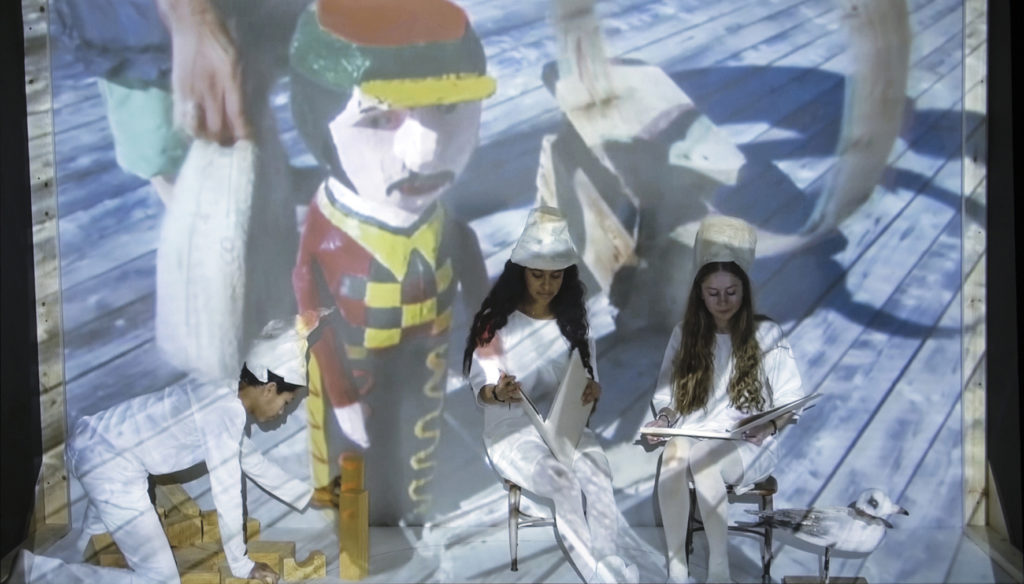
Joan Jonas, They Come to Us without a Word, 2015. Production Still. Courtesy of the artist.
ST: What do you think about the Rose Museum's forthcoming participation with Mark Bradford?
PH: I'm looking forward to it. It's tremendously exciting that an institution from Boston was chosen, and Mark Bradford is a fantastic artist. He can do so much that I'm really curious about what he does. It could be a painting, it could be an object installation, it could be performance, it could be video. There are a lot of possibilities.
When you get the call and you realize how much there is to get done, you panic a little. The obvious thing to do is to reach out to the past commissioners. I have to say Holly Block, Carey Lovelace, Lisa Freiman, who commissioned the last two Sarah Sze and Allora and Calzadilla exhibitions, they were incredibly generous in spirit and they shared all the large and small problems they faced and how they solved them. I'm going to be exactly the same way in their generous spirit and being able to share what we went through if it can help in any way. Of course, every show is different, so every show has its challenges and rewards. It's mostly logistics that are the most daunting because most of us have not done an exhibition in Venice. How do you get this box over to Venice, and how much will that cost? My colleagues went flat out helping us. I want to be able to do the same.
ST: There are many great curators who have mounted exhibitions for the US Pavilion, including giants of the field like Sam Hunter, Rosalind Krauss, Robert Hobbs, Nancy Spector, Linda Norden. How does it feel to be added to that list?
PH: I feel incredibly honored. What makes it so gratifying is seeing how Joan is being propelled to her next level in terms of her career. She's going to be showing everywhere pretty soon. Her production has just gone into overdrive. I'm so happy about that. One of the things that Joan experienced is that she had an incredibly dedicated audience who championed her work, but she didn't have wider exposure. Knowing that in Venice, we had 500,000 people physically visit the pavilion, that's an audience. I know there's going to be a million other people that are going to be exposed to her work, and they'll become a better person if they're exposed to her work. That's what I am the most proud of.
ST: How do you think your work at White Columns relates to that sentiment, fostering interest and support for underrecognized artists?
PH: My work at White Columns was incredibly gratifying, and in a way formed me as to who I am today. Some of my best colleagues are colleagues who are generous open and accessible, and White Columns gave me the ethos to be that kind of a curator and a director. I visited 900 studios a year. I got exposed to a ton of artists, and at the same time, the more artists I met, the more artists I wanted to support.
White Columns is still an important institution and they've given opportunities to many artists that we know and love today.
ST: It is an exciting time in the Greater Boston Area for curatorial practices in Contemporary Art. Can you tell us what you think this back-to-back representation says about the strength of our local academic and institutional activity in the global contemporary art community?
PH: I think Bostonians are very self-effacing in a way. When people find out I am at the contemporary art museum at MIT they're very sheepish to say, "Boston really doesn't support contemporary art." I have to remind them that that's not really the case, that's not what the data shows. The fact is that The Isabella Stewart Gardner Museum has recently opened a new wing and have developed a residency program. I remind them of the millions of dollars that the Museum of Fine Arts Boston spent on a new contemporary art wing, and the only new art museum built [in Boston]in the last 100 years was The Institute of Contemporary Art. There's an incredible excitement and support for contemporary art in Boston. Maybe that's some of the reasons why the panel looked at Boston again. There is so much going on.
What I'm also really excited about is Matthew Teitelbaum, who was a contemporary art curator, now runs the biggest institution of record here in Boston, which is the MFA. I'm hoping he will champion contemporary art, and the general public will realize that contemporary art should be supported and it is what Boston excels at, and hopefully there are more collectors, there are more galleries. There are so many universities that have studio and art history departments here. Right now, a lot of the professors are commuters from NY, LA, Chicago, and I'm hoping they decide to plant themselves and become part of the larger community here in Boston.
Jonas has taught at MIT since 1998 and is currently Professor Emerita in the MIT Program in Art, Culture, and Technology within the School of Architecture and Planning. She has exhibited, screened and performed her work at museums and galleries in large-scale group exhibitions throughout the world, such as: the Taipei Biennial; Documenta 5, 6, 7, 8, 11, and 13; the 2008 Sydney Biennial; the 2008 Yokohama Triennial; and the 28th Sao Paolo Biennial. In response to her commission at the United States Pavilion for the 56th Venice Biennale, her work has recently been recognized with more focused, international solo exhibitions. In January of 2016, Joan Jonas: They Come to Us without a Word was adapted for the NTU Centre for Contemporary Art Singapore by Ute Meta Bauer. Currently, Joan Jonas: stream or river, flight or pattern curated by Benjamin Weil, is on view at the Fundación Botín in Santander, Spain, through October 16th, 2016, and five decades of Jonas’s works are being presented in her first Canadian retrospective, Joan Jonas: From Away, curated by Barbara Clausen, on view through September 18th, 2016 at the DHC/ART Foundation for Contemporary Art in Montreal.
More information about Joan Jonas: They Come to Us without a Word can be found here: http://joanjonasvenice2015.com/
This transcription was edited for clarity.

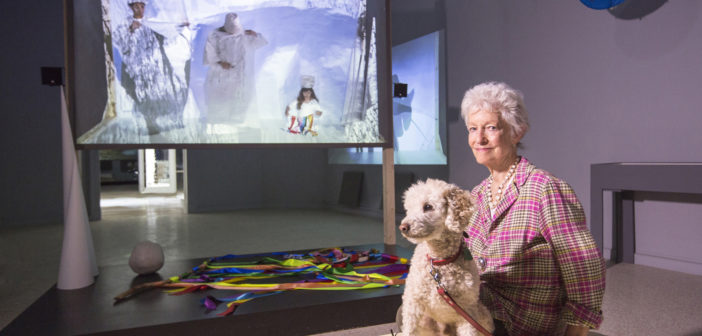
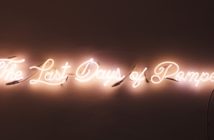
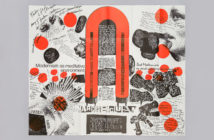
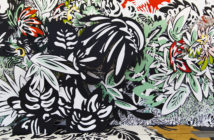
2 Comments
Pingback: Morning Links: Helen Torr and Arthur Dove Edition | ARTnews
I enjoyed this interview and the introductions to Paul Ha and Joan Jonas and their work. It’s incredible how much work goes into the Biennale exhibition. Well done.